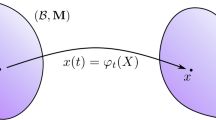Abstract
For the classical Euler elastic problem, conjugate points are described. Inflexional elasticas admit the first conjugate point between the first and third inflexion points. All other elasticas do not have conjugate points. As a result, the problem of stability of Euler elasticas is solved.
Similar content being viewed by others
References
A. A. Agrachev, Geometry of optimal control problems and Hamiltonian systems. Lect. Notes Math. CIME 1932 Springer-Verlag (2008), pp. 1–59.
A. A. Agrachev and Yu. L. Sachkov, Geometric control theory. Fizmatlit, Moscow (2004); English transl.: Control Theory from the Geometric Viewpoint. Springer-Verlag, Berlin (2004).
V. I. Arnold, On a characteristic class entering quantization conditions. Funct. Anal. Appl. 1 (1967), No. 1, 1–14.
V. I. Arnold and A. B. Givental, Symplectic geometry. Encycl. Math. Sci. 4 Springer-Verlag (1998), pp. 1–136.
M. Born, Stabilität der elastischen Linie in Ebene und Raum. Preisschrift und Dissertation, Dieterichsche Universitäts-Buchdruckerei Göttingen (1906). Reprinted in: Ausgewählte Abhandlungen, Vol. 1, Vanderhoeck & Ruppert, Göttingen (1963), pp. 5–101.
R. Brockett and L. Dai, Non-holonomic kinematics and the role of elliptic functions in constructive controllability. In: Nonholonomic Motion Planning (Z. Li and J. Canny, Eds.), Kluwer, Boston (1993), pp. 1–21.
L. Euler, Methodus inveniendi lineas curvas maximi minimive proprietate gaudentes, sive solutio problematis isoperimitrici latissimo sensu accepti. Lausanne, Geneva (1744).
D. F. Lawden, Elliptic functions and applications. Springer-Verlag (1989).
A. E. H. Love, A treatise on the mathematical theory of elasticity. Dover, New York (1927).
Yu. L. Sachkov, Complete description of the Maxwell strata in the generalized Dido problem. Mat. Sb. 197 (2006), No. 6, 111–160.
——, Maxwell strata in the Euler elastic problem. J. Dynam. Control Systems 14 (2008), No. 2, 169–234; available at arXiv:0705.0614 [math.OC], 3 May 2007.
——, Exponential mapping in Euler’s elastic problem. In preparation.
A. V. Sarychev, The index of second variation of a control system. Mat. Sb. 113 (1980), 464–486.
E. T. Whittaker and G. N. Watson, A course of modern analysis. Cambridge Univ. Press, Cambridge (1996).
S. Wolfram, Mathematica: A system for doing mathematics by computer. Addison-Wesley, Reading (1991).
Author information
Authors and Affiliations
Corresponding author
Additional information
This work was supported by the Russian Foundation for Basic Research, project No. 06-01-00330.
Rights and permissions
About this article
Cite this article
Sachkov, Y.L. Conjugate Points in the Euler Elastic Problem. J Dyn Control Syst 14, 409–439 (2008). https://doi.org/10.1007/s10883-008-9044-x
Received:
Revised:
Published:
Issue Date:
DOI: https://doi.org/10.1007/s10883-008-9044-x



